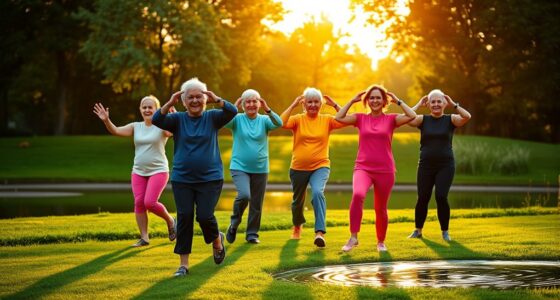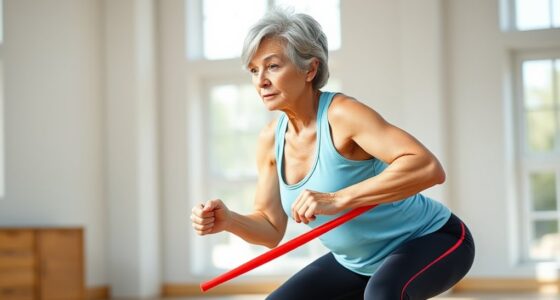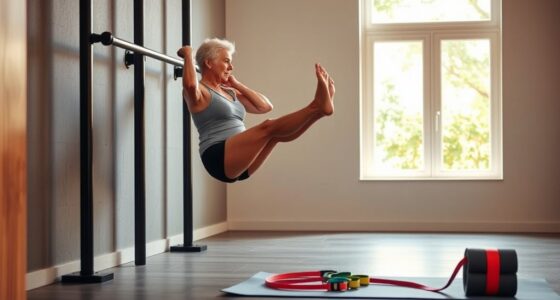Leg strengthening exercises are essential for helping seniors stand tall again. By improving your leg strength, you enhance mobility, balance, and stability, greatly reducing your fall risk. Key exercises like squats, sit-to-stands, and chair deadlifts can significantly boost your strength. Consistent practice can lead to improved recovery skills and greater independence in daily activities. Plus, minor adjustments can increase your exercise’s effectiveness. Keep going to discover more exercises and tips for maintaining and boosting your strength!
Key Takeaways
- Leg strengthening exercises improve mobility and balance, reducing the risk of falls and promoting independence in daily activities.
- Incorporating sit-to-stands, squats, and calf raises enhances muscle strength and stability for better functional movement.
- Regular exercise supports emotional well-being, aiding in stress management and overall mental health.
- Mindfulness techniques during exercises can increase self-awareness, helping seniors maintain better control over their movements.
- Consistent participation in leg exercises can lead to a 30-50% reduction in fall risk, fostering a safer living environment.
The Importance of Leg Strengthening for Seniors
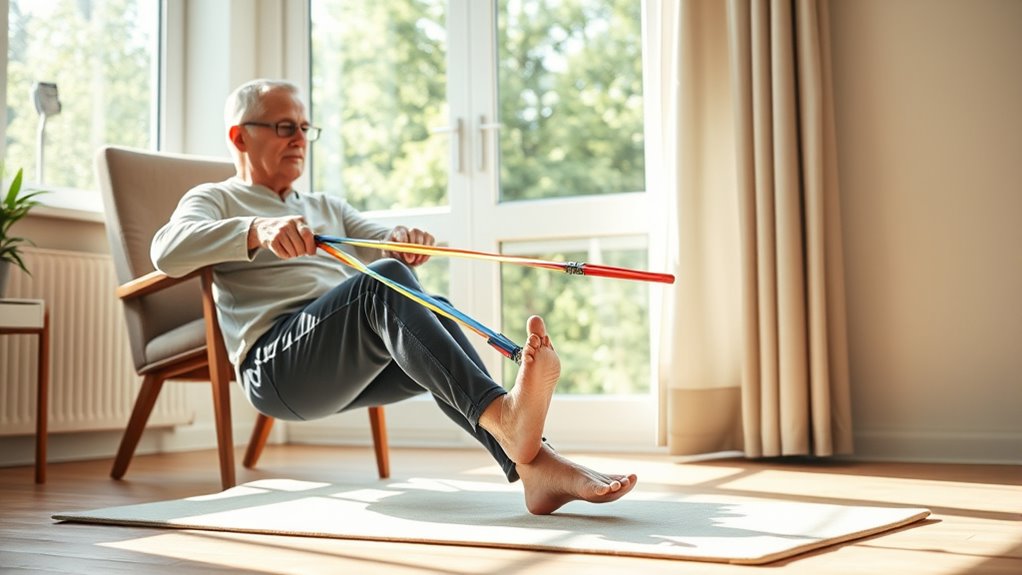
As you age, maintaining leg strength becomes vital for your overall well-being.
Leg strengthening exercises enhance mobility and balance, which are essential for falls prevention. By incorporating strength training into your routine, you can improve coordination and stability, allowing you to navigate daily activities with greater ease. This independence contributes greatly to your quality of life. Moreover, creating transforming spaces that accommodate your exercise routine can further enhance your engagement and motivation. Additionally, regular exercise can support emotional regulation, which is essential for managing stress and maintaining mental health. Furthermore, adopting continuous learning about safe exercise techniques can further empower seniors to engage confidently in their fitness journey. Engaging in activities that promote cognitive skills can also enhance your overall mental sharpness.
Furthermore, strong legs support bone health, reducing the risk of osteoporosis and fractures. If you deal with osteoarthritis, regular leg workouts can alleviate pain, promoting better comfort and mobility.
Finally, enhancing your recovery skills through consistent leg exercises means you can react more swiftly to potential balance issues, further safeguarding against injuries. Furthermore, engaging in these exercises can lead to improved mood and emotional well-being, which is crucial for overall mental health as you age.
Prioritize leg strength; it’s a key component of healthy aging.
Benefits of Preventing Falls
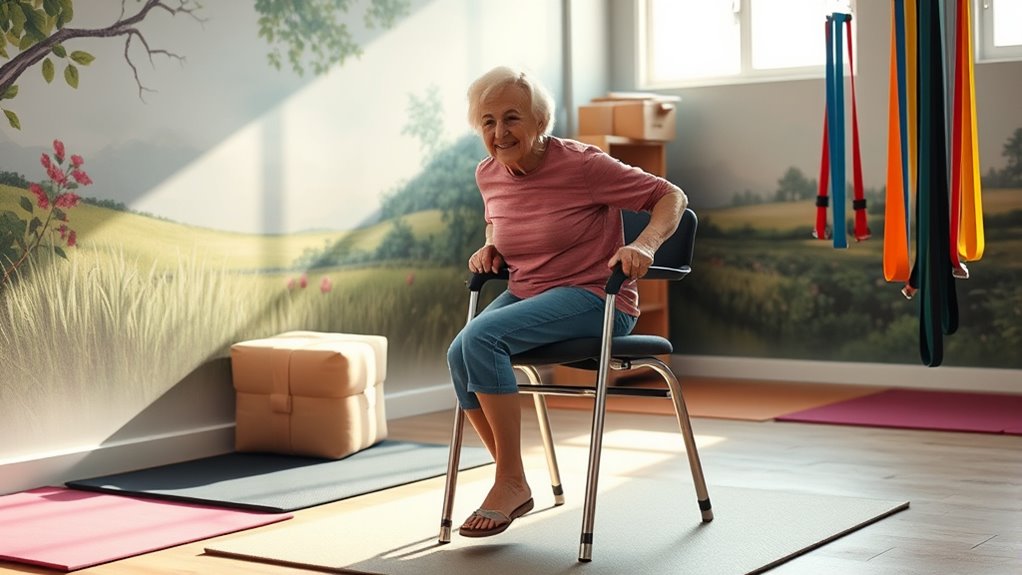
Preventing falls is essential for maintaining your independence as you age.
By engaging in leg strengthening exercises, you’ll enhance your balance and coordination, making it easier to navigate your environment safely. Additionally, managing behavioral issues in seniors can further contribute to a safer living environment. Improved recovery skills from these exercises also help you react quickly to any potential slips, reducing your risk of injury. Furthermore, practicing mindfulness techniques can enhance your self-awareness and help you stay centered while moving about your surroundings. Additionally, participating in spiritual retreats can provide holistic support for your overall wellbeing, similar to how emerging regulations in Kenya advances crypto regulation framework aim to foster stability. Incorporating leafy greens into your diet can also support cognitive function, which is crucial for maintaining balance and spatial awareness as you age. Leg exercises can provide a solid foundation for your physical health and safety.
Enhanced Balance and Coordination
When you engage in targeted leg strengthening exercises, you’re not just building muscle; you’re also enhancing your balance and coordination, which are essential for reducing the risk of falls.
For seniors, improved muscle strength means greater stability, making it easier to navigate daily activities without fear of falling. Additionally, incorporating Alzheimer bracelets can provide added safety by ensuring identification in case of emergencies while exercising. It’s also important to remember that open communication about feelings can help seniors express any fears they may have about falling, further enhancing their confidence. Engaging in fitness programs tailored to all age groups can provide structured support for these exercises. Furthermore, studies indicate that audiometric testing can be beneficial for those experiencing hearing issues, as it helps identify any underlying conditions that may affect balance.
Studies show that consistent leg strengthening can decrease fall risk by 30-50%, greatly boosting your confidence in mobility.
Enhanced balance and coordination allow you to maintain independence, as you’ll feel more secure when standing, walking, or moving around your home. Additionally, incorporating data-driven decision-making into your exercise routine can help you track progress and adjust your activities for optimal results.
Improved Recovery Skills
Improved recovery skills are vital for seniors, especially in moments of unexpected balance loss. Engaging in leg strengthening exercises can greatly enhance your balance and coordination, reducing the risk of falls. Regular strength training not only helps you react effectively during these moments but also reduces fall-related injuries by up to 50%. By exercising regularly, you’ll notice improved mobility, which is important for maintaining your independence in daily activities. Those who participate in leg strengthening activities experience a 30% lower incidence of falls, showcasing the significance of these exercises. Strengthening your legs fosters better stability, allowing you to enjoy a more active lifestyle and recover quickly if you do encounter balance issues. Additionally, incorporating omega-3 rich foods into your diet can further support overall health and recovery. Engaging in regular exercise can also improve socialization opportunities for seniors, enhancing their interaction with others. Furthermore, incorporating essential oils for dizziness relief may provide additional support during moments of imbalance. It’s important to recognize that embracing the journey to parenthood can also inspire a more active lifestyle as you focus on maintaining your health. Furthermore, understanding the impact of necessary cookies on your online experience can help you manage your privacy better while seeking health resources.
Embrace leg strengthening for greater confidence and safety!
The Best Leg Exercises for Seniors

Leg exercises play an essential role in maintaining your strength and balance as you age, making it easier to perform daily activities. Incorporating effective leg strengthening exercises can greatly enhance your mobility and reduce the risk of falls. Here are some top exercises for seniors:
| Exercise | Benefits |
|---|---|
| Sit-to-Stands | Strengthens quads and glutes |
| Calf Raises | Enhances calf strength and balance |
| Resistance Bands | Increases muscle challenge |
| Lunges | Improves coordination and stability |
Aim for at least three sessions per week, starting with 1 set of 10-12 repetitions. As you progress, increase to 3 sets. These exercises help maintain your independence, supporting essential movements like standing and traversing stairs. Additionally, engaging in regular exercise is critical for maintaining a healthy weight and preventing behavioral issues in dogs, which can be mirrored in the importance of physical activity for seniors. Regular leg exercises are part of a broader strategy to enhance life at home for the elderly, ensuring a safer and more comfortable living environment. Furthermore, participating in outdoor activities, such as hiking and wildlife observation, can provide additional motivation to stay active and enjoy the natural beauty around you. Consistent leg exercise can also contribute to improved mobility and overall physical health, which is vital for older adults. Additionally, incorporating portable camping toilets during outdoor excursions can ensure comfort and convenience, allowing seniors to stay active without added stress.
Strength Exercise 1: Squat
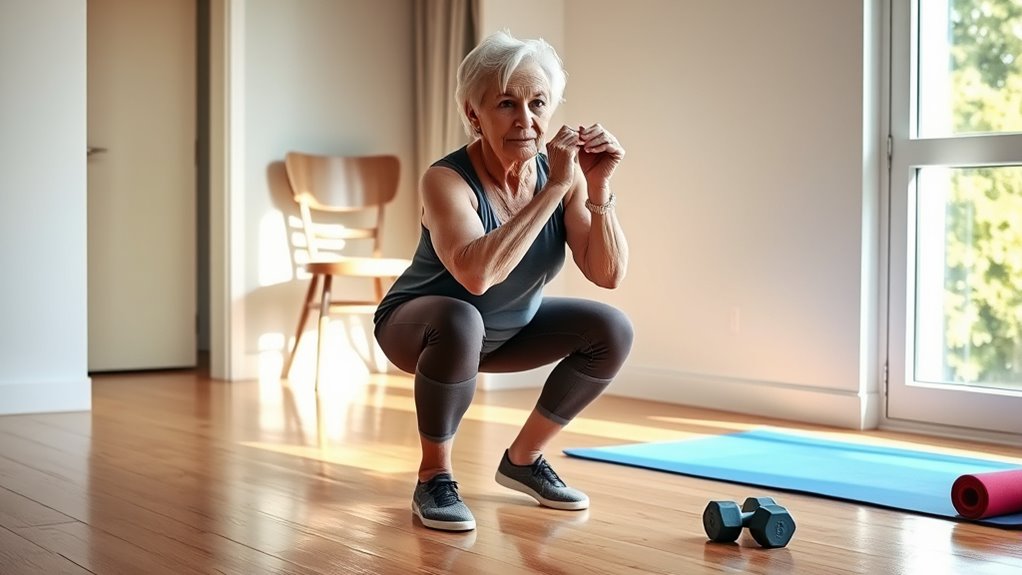
One of the most effective exercises you can incorporate into your routine is the squat. This lower body exercise primarily targets your glutes, quadriceps, hips, calves, core, and back, promoting overall leg strength and stability.
To perform a squat, stand with feet shoulder-width apart, hinge at your hips, and lower your body to a 90-degree angle while keeping your knees behind your toes. For seniors, this moderate exercise enhances functional mobility.
Start with 10-12 repetitions and aim for at least three times per week. You can progress by using no hands for support, adding resistance bands, or incorporating dumbbells to increase the challenge.
Integrating squats into your health plan can greatly boost your exercise program’s effectiveness.
Strength Exercise 2: Sit-to-Stand
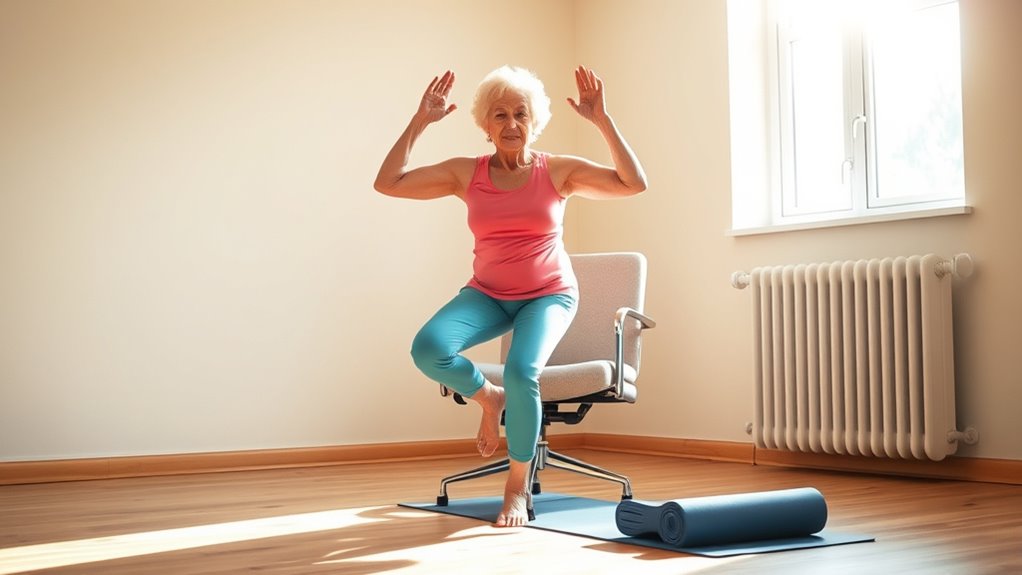
When you incorporate the Sit-to-Stand exercise into your routine, you’ll engage multiple muscle groups, including the glutes, quads, and core.
This easy to moderate exercise is perfect for seniors, enhancing functional mobility and strength for daily activities. Here’s how to get started:
- Shuffle forward on a chair, keeping your feet shoulder-width apart.
- Lean slightly forward, then stand up fully extending your legs.
- Sit back down with control.
To increase the challenge, consider these progressions:
- Use a lower chair to deepen the movement.
- Perform the Sit-to-Stand without hand assistance.
- Incorporate variations to keep it engaging.
Regular practice will strengthen your lower body and improve your overall independence!
Strength Exercise 3: Chair Deadlift
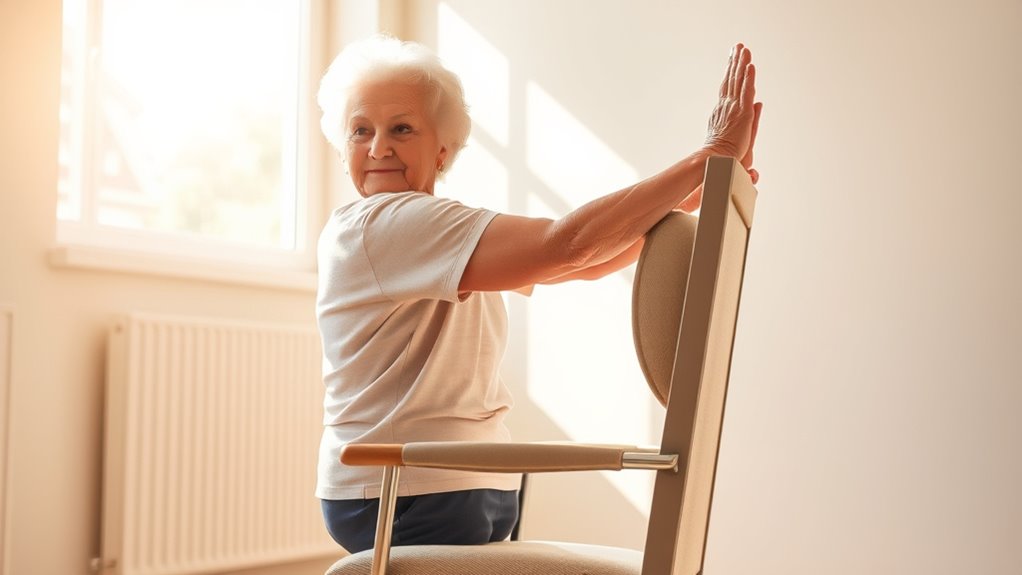
The Chair Deadlift is a powerful exercise that targets multiple muscle groups, including your glutes, quads, hips, calves, core, and back.
For seniors, this exercise enhances lower body strength and improves stability, essential for maintaining functional mobility.
To perform the Chair Deadlift, place a resistance band under your feet while seated. Maintain an upright posture and stand up completely, squeezing your glutes at the top.
Start with lighter resistance and progress as your strength improves.
Safety tips include ensuring equal weight distribution on both legs and keeping your knees aligned throughout the movement to avoid injury.
Regular practice of the Chair Deadlift can greatly benefit your overall strength and mobility, helping you stand tall again.
Strength Exercise 4: Reverse Lunge
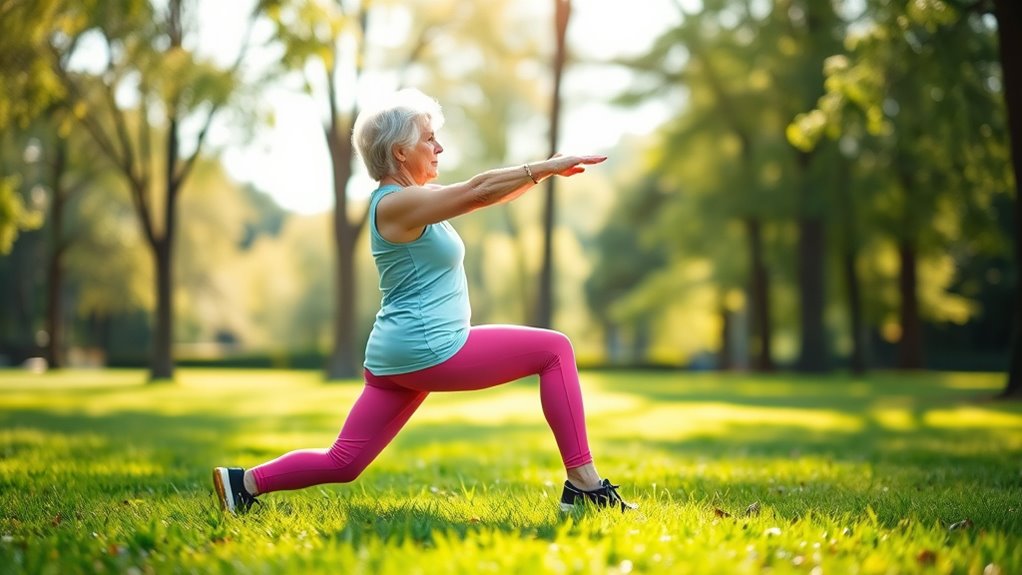
Reverse Lunges are a fantastic way to strengthen your lower body while improving balance and stability. This effective strength exercise targets your glutes, quads, and core, enhancing leg strength and mobility.
To perform a reverse lunge, step back with one leg while keeping your front knee behind your toes.
Here are a few tips to keep in mind:
- Start with shallow lunges if you’re new to the exercise.
- Progress by increasing the depth or adding weights for more resistance.
- Consistent practice can greatly aid in fall prevention.
Incorporating reverse lunges into your routine not only boosts your leg strength but also improves overall coordination, making it an essential exercise for seniors.
Additional Leg Exercises
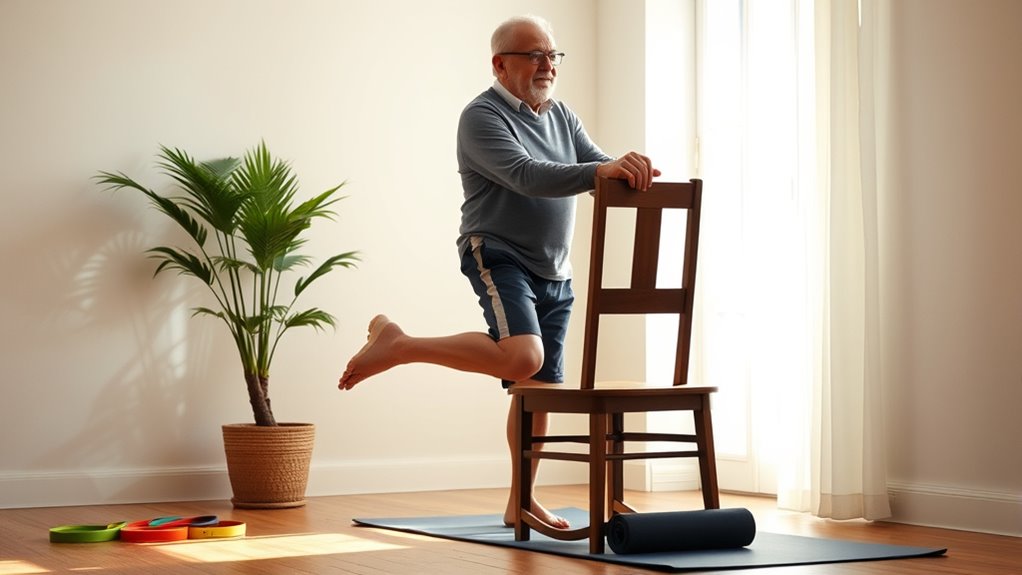
Building on the benefits of reverse lunges, incorporating a variety of leg exercises can further enhance your strength and stability.
Calf Raises are excellent for strengthening your legs, as they target the lower leg muscles, boosting your mobility and making it easier to navigate stairs.
Hip Abductions focus on your glutes, improving balance and stability during daily activities.
Hip Extensions engage your glutes and hamstrings, contributing to better posture and functional movement.
Knee Flexions work your hamstrings, essential for standing up and walking.
You can modify each of these exercises with resistance bands to increase difficulty and promote strength gains over time.
Tips for Consistency in Exercise

To maintain consistency in your exercise routine, it’s essential to establish a regular schedule that fits your lifestyle. Aim for at least three times per week to effectively build strength and improve leg strength over time.
Establish a regular exercise schedule that suits your lifestyle, aiming for at least three times a week for optimal strength gains.
Here are some tips to help you stay active:
- Set realistic and achievable goals to keep motivation high, like increasing your sets gradually.
- Consider joining group classes for a supportive environment that encourages accountability and consistency in exercising.
- Break workouts into manageable sessions throughout the day if needed, making it easier to prioritize your fitness.
Remember to track progress by noting completed sets and repetitions, as this boosts motivation and shows how far you’ve come.
Consistency is key!
Frequently Asked Questions
Can Elderly Regain Leg Strength in Elderly?
Yes, you can regain leg strength as you age.
By incorporating consistent leg strengthening exercises into your routine, you’ll improve mobility and reduce the risk of falls.
Start with simpler exercises like squats and lunges, gradually increasing their intensity.
Aim to exercise about three times a week, performing 10-12 repetitions each time.
This approach not only builds muscle but also enhances your overall health and independence in daily activities.
How Can I Train My Legs to Stand Longer?
To train your legs for standing longer, start incorporating exercises like squats, lunges, and calf raises into your routine at least three times a week.
Aim for 10-12 repetitions per session. You can also use resistance bands or dumbbells to enhance strength and stability.
Begin with simpler exercises like sit-to-stands and gradually progress.
How Long Does It Take to Rebuild Leg Strength?
Rebuilding leg strength is like nurturing a plant; it takes time and care to flourish.
Typically, you’ll notice improvements within 4 to 12 weeks, depending on your starting fitness level and consistency. If you commit to training at least three times a week, you might see a 20-40% increase in muscle strength within 12 weeks.
Early changes in balance and mobility can often appear within just 2 to 4 weeks of dedicated effort.
What Is the Best Leg Exerciser for Seniors?
When considering the best leg exerciser for seniors, think about options like resistance bands and recumbent exercise bikes.
Resistance bands are versatile and easy to use, allowing you to perform various exercises safely.
Recumbent bikes offer a comfortable way to strengthen your legs while also improving cardiovascular health.
Seated leg extension machines can help you target specific muscles without straining your joints.
Choose what suits you best to keep your legs strong and mobile.
Conclusion
Incorporating leg strengthening exercises into your routine can help you stand tall and regain confidence as you move. With a few simple workouts, you’ll not only boost your strength but also reduce the risk of falls. Remember, it’s never too late to take the first step toward better mobility. So, lace up those sneakers and get started—your legs will thank you, and soon you’ll be back on your feet, ready to take on the world!



